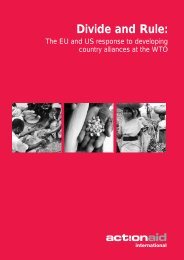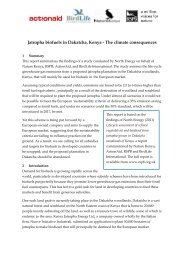Tea break - ActionAid
Tea break - ActionAid
Tea break - ActionAid
- No tags were found...
Create successful ePaper yourself
Turn your PDF publications into a flip-book with our unique Google optimized e-Paper software.
<strong>Tea</strong> <strong>break</strong>: a crisis brewing in India<br />
operating costs incurred by tea companies. Hindustan<br />
Lever announced in 2004 that: “We have considerably<br />
improved the shape of our food business, with gross<br />
margin improvement of about 13% in the last three<br />
years… Our continued focus on operational<br />
efficiencies and cost reduction has resulted in very<br />
good improvement in our operating margins.” 21<br />
At the same time the large tea buying companies such<br />
as Hindustan Lever and Tata <strong>Tea</strong> have continued to<br />
reap increased dividends for their shareholders. Since<br />
1996 Hindustan Lever’s shareholder dividends have<br />
quadrupled from 1.25 rupees dividend on one rupee<br />
share in 1996 to 5.50 rupees dividend in 2003. 23<br />
Beverages make up approximately 10% of Hindustan<br />
Lever’s total revenues of 102 billion rupees (£1.25<br />
billion) and Brooke Bond, its leading packaged tea<br />
brand, is the second biggest brand in its entire<br />
portfolio. 24 Despite the problems in the tea sector,<br />
Hindustan Lever’s finance director predicts a bright<br />
future for its tea business: “In tea, we see a lot of value<br />
associated with branding. Brooke Bond is a very strong<br />
brand and we plan to re-launch it. The tea business<br />
also has a good margin profile and offers much scope<br />
for value addition and differentiation through<br />
packaging.” 25<br />
Tata <strong>Tea</strong> has also recorded healthy profit margins in the<br />
last two years and according to an investor report in<br />
January 2005 its “Indian operations were strong mainly<br />
owing to improved realisations on garden tea and<br />
strong performance of its branded tea operations.” 26<br />
A 2005 report for the International Labour Organisation<br />
(ILO) notes that the large tea companies are benefiting<br />
from the fall in auction prices and rise in retail prices<br />
for tea:“This widening gap between consumer and<br />
auction prices…is cutting into the margins realised by<br />
the tea producers but is not being passed on to the<br />
consumer in the form of lowered tea prices.” 27<br />
Similarly a report by the government of Assam<br />
published in 2004 found it “unfathomable that the retail<br />
price of tea has not come down with the fall of auction<br />
prices. Certainly, the margins of intermediaries are<br />
far too high.” 28<br />
Whether the large tea companies use their market<br />
power to push down prices or take advantage of<br />
depressed markets to pay low prices, they are clearly<br />
benefiting from the current situation. Meanwhile many<br />
tea workers and producers are suffering hunger and<br />
malnutrition as they struggle to make a living from<br />
growing tea.<br />
<strong>ActionAid</strong> research<br />
<strong>Tea</strong> workers in India are highly dependent on<br />
plantations for food, drinking water, housing, education<br />
and healthcare. 29 The majority are migrant workers or<br />
tribal peoples and plantations are often situated in<br />
isolated, remote areas. The closure of plantations has<br />
left workers with few alternative means of livelihood<br />
or support. 30<br />
Plantations that have remained open have cut or failed<br />
to pay workers’ wages, demanded tougher standards<br />
on quantity and quality from tea pluckers, replaced<br />
permanent workers with casual labourers and denied<br />
legal entitlements such as adequate housing, drinking<br />
water, electricity and healthcare to workers. 31<br />
The tea crisis has also resulted in the closure of<br />
plantation medical facilities. Some women have died<br />
during pregnancy because of inadequate healthcare 32<br />
and many children on the tea plantations have stopped<br />
going to school, as they cannot afford the commute,<br />
uniforms and books they need. 33<br />
<strong>ActionAid</strong> research in Tamil Nadu found:<br />
■ workers paid lower wages for increased workloads<br />
■ workers suffering hunger and malnutrition<br />
■ workers facing increasing job insecurity<br />
■ smallholder tea growers struggling to feed<br />
their families<br />
■ tribal communities harassed by plantation owners.<br />
1 workers paid lower wages for increased<br />
workloads<br />
Wage cuts and the introduction of heavier quotas for<br />
plantation workers have become common throughout<br />
the tea sector in India. 34<br />
“At the Hindustan Lever estates the wage level since<br />
the mid nineties declined from around 79 rupees per<br />
day for its own workers to 71 rupees per day,” says<br />
Gautam Mody, from the secretariat of the New Trade<br />
Union Initiative. 35 “At the same time, the productivity<br />
required increased nearly two and a half times from<br />
8-12 kg leaf per day to up to 30 kg. The situation for<br />
contract labourers is bound to be worse.” 36<br />
On its Davershola estate in Tamil Nadu, Hindustan<br />
Lever announced a wage increase for workers from 71<br />
rupees to 72 rupees in January 2005 but also increased<br />
fighting poverty together 5

















